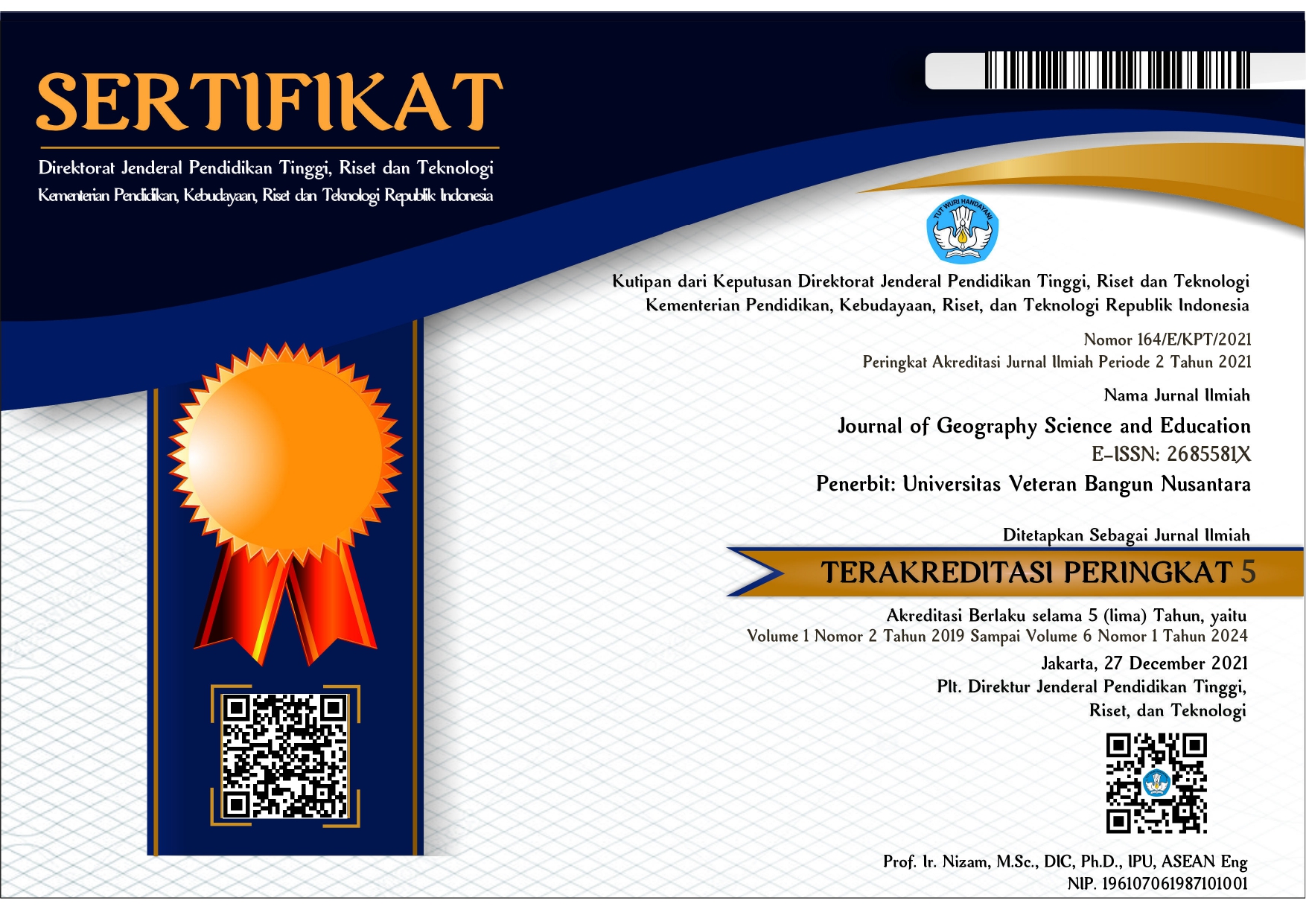Environmental Information System for Disaster Risk Management at Kota Surakarta
DOI:
https://doi.org/10.32585/jgse.v5i1.4215Keywords:
ecosystem, disaster risk reduction, environmental information systemAbstract
Through this activity, disaster volunteers in Surakarta City can conduct disaster risk reduction (DRR) efforts based on ecosystem data and information management. Climate change has an increasing impact on ecosystems, resulting in environmental damage, thereby increasing the intensity of disaster events that need to be studied and monitored. Managing this disaster risk data and information requires using an environmental information system for ecosystem-based disaster risk reduction (ECO-DRR). The capacity of volunteers is vital in dealing with the risks of natural disasters and the impact of climate change by using SIL. Currently, volunteers manage using a form that has yet to accompany the presentation of information for decision-making and management of disaster risk knowledge. Requires remedial action by increasing the ability of volunteers to manage disaster risk data and information, report disaster events, and present them in dashboards. The method used is the parameters fordevelopment of SIL as a solution for ecosystem-based disaster risk reduction (ECO-PRB). The parameterswereconducted on the topics of disaster risk, disaster incident reporting, and dashboard information management. The development of ECO-DRR SIL uses Quality Function Deployment (QFD) to obtain information on improvements in developing a user-based digital platform
Downloads
References
Agustianingsih, D. P., Ariyaningsih, & Shaw, R. (2023). Community disaster resilience using multi-hazard assessment during Covid-19: The case of Denpasar, Indonesia. Natural Hazards Research. https://doi.org/10.1016/J.NHRES.2023.04.006
Cos-Guerra, O. D., Castillo-Salcines, V., & Cantarero-Prieto, D. (2022). A geographical information system model to define COVID-19 problem areas with an analysis in the socio-economic context at the regional scale in the North of Spain. Geospatial Health, 17(s1). https://doi.org/10.4081/gh.2022.1067
Data dan Informasi Bencana Indonesia (DIBI). (2022, December 17). Badan Nasional Penanggulangan Bencana (BNPB).
Dou, M., Chen, J., Chen, D., Chen, X., Deng, Z., Zhang, X., Xu, K., & Wang, J. (2014). Modeling and simulation for natural disaster contingency planning driven by high-resolution remote sensing images. Future Generation Computer Systems, 37, 367–377. https://doi.org/10.1016/J.FUTURE.2013.12.018
Fakhriati, F., Nasri, D., Mu’jizah, M., Supriatin, Y. M., Supriadi, A., Musfeptial, M., & Kustini, K. (2023). Making peace with disaster: A study of earthquake disaster communication through manuscripts and oral traditions. Progress in Disaster Science, 18, 100287. https://doi.org/10.1016/J.PDISAS.2023.100287
Mao, Q., Li, N., & Peña-Mora, F. (2019). Quality function deployment-based framework for improving the resilience of critical infrastructure systems. International Journal of Critical Infrastructure Protection, 26, 100304. https://doi.org/10.1016/J.IJCIP.2019.100304
Modarresi, S. A., & Maleki, M. R. (2023). Integrating pre and post-disaster activities for designing an equitable humanitarian relief supply chain. Computers & Industrial Engineering, 181, 109342. https://doi.org/10.1016/J.CIE.2023.109342
Nissen, S., Carlton, S., Wong, J. H. K., & Johnson, S. (2021). ‘Spontaneous’ volunteers? Factors enabling the Student Volunteer Army mobilisation following the Canterbury earthquakes, 2010–2011. International Journal of Disaster Risk Reduction, 53, 102008. https://doi.org/10.1016/J.IJDRR.2020.102008
Paudel, P. K., Lamichhane, A., Acharya, K. P., & Bastola, R. (2023). Ecosystem restoration reduces community vulnerability to water-induced disasters: Need to rethink Chure conservation in Nepal. International Journal of Disaster Risk Reduction, 90, 103647. https://doi.org/10.1016/J.IJDRR.2023.103647
Rachmawati, E., Umniyatun, Y., Rosyidi, M., & Nurmansyah, M. I. (2022). The roles of Islamic Faith-Based Organizations on countermeasures against the COVID-19 pandemic in Indonesia. Heliyon, 8(2), e08928. https://doi.org/10.1016/J.HELIYON.2022.E08928
Rafi, M. M., Aziz, T., & Lodi, S. H. (2018). A comparative study of disaster management information systems. Online Information Review, 42(6), 971–988. https://doi.org/10.1108/OIR-06-2016-0168
Sakya, A. E., Frederik, M. C. G., Anantasari, E., Gunawan, E., Anugrah, S. D., Rahatiningtyas, N. S., Hanifa, N. R., & Jumantini, N. N. E. (2023). Sow the seeds of tsunami ready community in Indonesia: Lesson learned from Tanjung Benoa, Bali. International Journal of Disaster Risk Reduction, 87, 103567. https://doi.org/10.1016/J.IJDRR.2023.103567
Valaei Sharif, S., Habibi Moshfegh, P., & Kashani, H. (2023). Simulation modeling of operation and coordination of agencies involved in post-disaster response and recovery. Reliability Engineering & System Safety, 235, 109219. https://doi.org/10.1016/J.RESS.2023.109219
Vishwanath, T., Shirwaikar, R. D., Jaiswal, W. M., & Yashaswini, M. (2023). Social media data extraction for disaster management aid using deep learning techniques. Remote Sensing Applications: Society and Environment, 30, 100961. https://doi.org/10.1016/J.RSASE.2023.100961
Wang, X., Zhang, X., Moman Shahzad, M., & Shi, X. (2021). Research on the disaster prevention mechanism of mega-sub controlled structural system by vulnerability analysis. Structures, 33, 4481–4491. https://doi.org/10.1016/J.ISTRUC.2021.07.036
Wardekker, A., Nath, S., & Handayaningsih, T. U. (2023). The interaction between cultural heritage and community resilience in disaster-affected volcanic regions. Environmental Science & Policy, 145, 116–128. https://doi.org/10.1016/J.ENVSCI.2023.04.008
Zar Chi Aye, Michel Jaboyedoff, Marc-Henri Derron, & Cees J. Van Westen. (2015). Prototype of a Web-based Participative Decision Support Platform in Natural Hazards and Risk Management. ISPRS International Journal of Geo-Information, 4(3), 1201–1224.
Downloads
Published
How to Cite
Issue
Section
License
Copyright (c) 2023 R. Muhammad Amin Sunarhadi, Prabang Setyono, Lia Kusumaningrum, Bayu Kurniaaji, Haydar Ally, Muhammad Hanif Ahsani Taqwim, Nida Ulhaq Fil'ardiani, Fadhil Achmad Zaky, Sa'ad Abdul Jabbar

This work is licensed under a Creative Commons Attribution-ShareAlike 4.0 International License.
Authors who publish with the Journal of Geography Science and Education agree to the following terms:
- Authors retain copyright and grant the journal the right of first publication with the work simultaneously licensed under a Creative Commons Attribution License (CC BY-SA 4.0) that allows others to share the work with an acknowledgment of the work's authorship and initial publication in this journal.
- Authors are able to enter into separate, additional contractual arrangements for the non-exclusive distribution of the journal's published version of the work (e.g., post it to an institutional repository or publish it in a book), with an acknowledgment of its initial publication in this journal.
- Authors are permitted and encouraged to post their work online (e.g., in institutional repositories or on their website) prior to and during the submission process, as it can lead to productive exchanges, as well as earlier and greater citation of published work.










